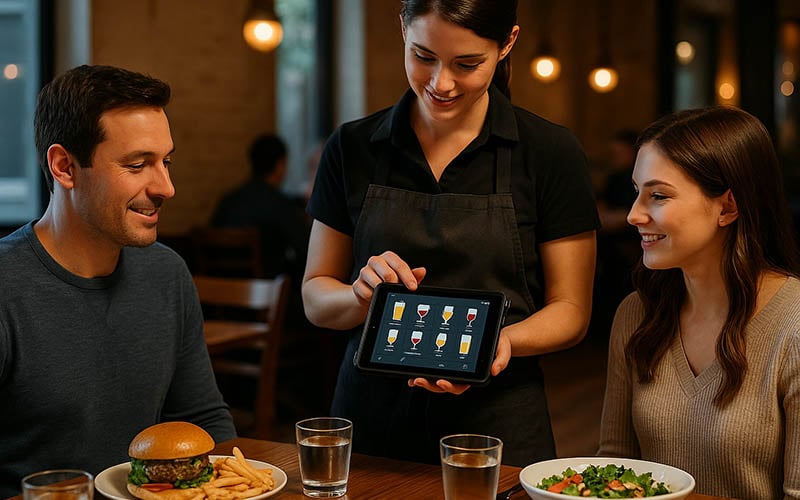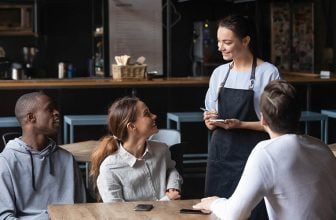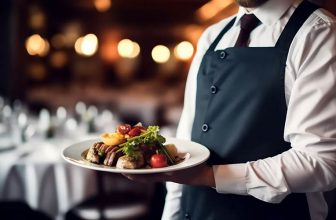
You know that server who somehow sells twice as many drinks as everyone else? They’re not just naturally gifted — they’ve figured out how to use restaurant technology to spot upselling opportunities before guests even realize they want another round.
I’ve watched restaurants completely transform their beverage sales once they started using restaurant POS systems with smart upselling features. It’s not about being pushy — it’s about having the right information at exactly the right moment to make suggestions that actually enhance the dining experience.
What Changes When You Get the Tech Right:
- Your servers get prompted with profitable drink pairings automatically
- Guest preferences get tracked so recommendations feel personal, not random
- Inventory alerts create natural urgency without being manipulative
- Timing becomes predictable instead of based on guesswork
- You can see what actually works instead of just hoping for the best
If bigger bar tabs and better tips are what you’re after, here’s how smart restaurant technology can turn every server into someone who naturally sells more drinks. Trust me — once you see how this works, you’ll wonder how restaurants ever managed without it.
Table of Contents
- 1 1. When Your POS Actually Helps You Sell
- 2 2. Remember Everyone’s Favorites Without Trying
- 3 3. Perfect Timing Without Constant Surveillance
- 4 4. Creating Urgency That Actually Works
- 5 5. Food and Drink Pairing Made Simple
- 6 6. See What Actually Works
- 7 7. Loyalty Programs That Feel Natural
- 8 8. Tableside Ordering That Captures Impulses
- 9 9. Training That Sticks
- 10 Finding Systems That Actually Help
- 11 The Bottom Line
1. When Your POS Actually Helps You Sell
Here’s something that surprised me when I first started working with restaurants: most servers forget to suggest drinks because they’re juggling fifteen other things. Even the good ones miss opportunities simply because there’s too much to remember.
That’s where smart POS suggestive selling really shines. The system watches what guests order and automatically pops up relevant suggestions. Someone orders spicy wings? Boom — the screen suggests cold beer or a frozen margarita. Taking drink orders stops being guesswork and starts being strategic.
- Drink suggestions appear the moment food items hit the order screen
- Seasonal cocktails and daily specials get highlighted when they’re relevant
- Premium upgrades show up for standard drink orders
What I love about this approach is that suggestions feel helpful instead of salesy. Your server isn’t randomly pushing expensive cocktails — they’re offering drinks that actually make sense with what you’re eating.
👉 Find POS systems with advanced upselling features — we’ve reviewed the best options.
2. Remember Everyone’s Favorites Without Trying

Every server has those regulars who order the same thing — but what about the guests who come in every couple months? Or that anniversary couple who tried four different wines last time? No human brain can track all that, but restaurant POS systems can.
When guests sit down, servers instantly see their drinking history. Last time they loved the pinot grigio? Perfect starting point for tonight’s wine recommendation. Great service becomes great sales when you actually remember what people enjoyed before.
- Wine preferences get tracked so you can suggest similar bottles
- Cocktail patterns help predict what new drinks they’ll actually like
- Special occasion drinks get noted for future celebrations
The reaction when you remember someone’s favorite drink from three months ago? That’s how you build customers for life. And honestly, it’s not your memory — it’s smart technology making you look like a hospitality genius.
3. Perfect Timing Without Constant Surveillance
Timing drink offers is tricky business. Too early and guests feel rushed. Too late and they’ve already moved on mentally. I’ve seen servers practically hover over tables trying to catch the perfect moment for round two — exhausting for everyone involved.
Modern POS systems track drink timing automatically. They know when each round was ordered, delivered, and how long guests typically take to finish. Visual cues tell servers when tables might be ready for another without requiring constant table stalking.
- Color indicators show which tables are likely ready for refills
- Timer alerts suggest natural moments to check in
- Table status updates help servers prioritize their rounds
This lets servers appear attentive without being annoying. Professional service means reading the room — technology just makes that reading more accurate and less obvious.
Reality Check: Technology Isn’t Magic
Look, I’ve worked with restaurants that thought fancy POS prompts would automatically turn mediocre servers into sales machines. Doesn’t work that way. If someone’s naturally pushy or clueless about reading guests, technology won’t fix that fundamental problem.
What it does do is give good servers better tools. The personality and sales instincts still come from the person — the POS just provides better timing and more relevant suggestions.
4. Creating Urgency That Actually Works
Nothing sells premium drinks like genuine scarcity. But most servers have no idea what’s actually running low until they try to order it and get shut down by the bar.
Smart inventory integration changes this completely. When that expensive bourbon is down to the last few pours, servers know immediately. They can create real urgency because the scarcity is legitimate, not manufactured.
- Low-stock alerts let servers mention limited availability honestly
- New arrival notifications help promote fresh inventory
- Seasonal tracking maximizes limited-time sales opportunities
When servers can say “we’re down to our last bottle of this wine” and actually mean it, guests respond differently than to generic sales pressure. Authentic urgency works because it’s… well, authentic.
5. Food and Drink Pairing Made Simple

The best beverage sales happen when drinks actually complement what people are eating. Problem is, not every server knows that hoppy IPAs cut through rich, fatty foods or that gewürztraminer pairs beautifully with spicy Asian cuisine.
POS pairing suggestions level the playing field. Order pad thai? The system suggests crisp white wines and light beers that actually work with those flavors. Even newer servers can make confident recommendations because the pairings are built into the system.
- Wine suggestions based on actual food flavor profiles
- Beer recommendations that consider dish richness and spice levels
- Cocktail suggestions for appetizers and small plates
Guests appreciate suggestions that enhance their meal rather than just boost their bill. When recommendations feel helpful, people trust them and order accordingly.
For example, when a server rings up spicy wings in Toast POS, the system automatically suggests cold beer options and frozen margaritas. If someone orders salmon, it prompts wine pairings like pinot noir or chardonnay. The suggestions appear right on the order screen, so servers can confidently say ‘this pairs perfectly with what you’re eating’ instead of just guessing.
6. See What Actually Works
Here’s what I find fascinating about restaurant beverage sales: most places operate on assumptions about what guests want instead of actual data. They think wine sales peak during dinner when the real money might be in afternoon cocktails.
POS analytics reveal the truth. Which servers consistently sell more drinks? What time of day produces the highest beverage margins? Which pairing suggestions actually get accepted by guests?
- Individual server performance shows which techniques work best
- Time-based patterns reveal optimal upselling moments
- Acceptance rates for different suggestions guide menu development
This data helps restaurants optimize everything from staff training to inventory purchasing. Instead of guessing what drives beverage sales, you know exactly what works in your specific operation.
7. Loyalty Programs That Feel Natural
Nobody likes obvious loyalty program manipulation, but everyone appreciates recognition for being a good customer. POS-integrated loyalty systems create opportunities that feel organic rather than forced.
When regular guests sit down, servers see their status automatically. Birthday coming up? Anniversary last month? These become natural conversation starters that lead to celebratory drink orders.
- Special occasion alerts suggest appropriate upgrades
- Point balances enable spontaneous reward redemptions
- Tier benefits encourage higher-value drink selections
The key is making rewards feel earned rather than marketed. When guests realize they’ve accumulated enough points for a premium cocktail, it becomes a treat rather than a sales pitch.
8. Tableside Ordering That Captures Impulses

Ever notice how guests change their minds between expressing interest and actually placing an order? That walk to the POS terminal gives them time to reconsider, and impulse purchases disappear.
Handheld mobile devices eliminate this lag time. Guest mentions they’re curious about the craft cocktail menu? Server pulls it up immediately, shows pictures, and processes the order before the moment passes.
- Visual drink menus help guests choose more confidently
- Immediate ordering captures spontaneous decisions
- Split payment options make group rounds effortless
This immediate response capability turns curiosity into sales. By the time servers return from distant terminals, the moment has often passed and guests have moved on mentally.
9. Training That Sticks
Teaching servers to upsell drinks effectively used to require extensive training and constant reinforcement. Now POS systems do much of that training automatically through guided prompts and real-time suggestions.
New servers learn successful techniques simply by following system prompts. Experienced staff can see their performance metrics and understand which approaches work best for their style.
- Built-in prompts teach proper upselling timing
- Performance tracking shows individual improvement areas
- Successful techniques get shared across the team automatically
This systematic approach creates consistency across your entire service team rather than relying on natural sales talent or extensive ongoing training programs.
Finding Systems That Actually Help
After watching dozens of restaurants implement different POS systems, here’s what I’ve learned: the ones that really boost beverage sales aren’t necessarily the most feature-rich. They’re the ones that integrate seamlessly into existing workflows without making servers jump through hoops.
Look for systems with intuitive upselling prompts, solid customer databases, and inventory integration that actually works during busy periods. The payback usually happens within 60-90 days through increased drink sales alone.
The Bottom Line
Smart beverage upselling isn’t about being pushy — it’s about having the right information at the right moment to make suggestions that genuinely enhance the dining experience.
When servers can see guest preferences, track timing patterns, and get intelligent prompts, they make recommendations that feel helpful rather than sales-driven. The result? Higher beverage sales, bigger tips, and guests who appreciate the personalized attention.
💡 Ready to transform your beverage sales with smart POS technology? We’ve reviewed the leading restaurant systems for upselling features, ease of use, and proven results in real-world operations.








